Fulfills the wishes of summer residents about a rich harvest - the "Goldfish" tomato and the secrets of its cultivation
Tomato is the most popular vegetable in the garden. It tastes good both fresh and canned, and many people love its juice. Red round tomatoes are traditionally grown everywhere, but if you want to try something new, plant bright, unusual and beautiful Golden Fish tomatoes.
Its original fruits will perfectly diversify your table and serve as a decoration for winter preparations. This variety is resistant to adverse weather conditions and has a high content of useful beta-carotene.
The content of the article
Description of the variety and characteristics of the fruit
Goldfish is an indeterminate variety, tomato grows up to 1.9 m... Such crop growth requires a garter and bush formation. It grows and bears fruit both in greenhouses and in the open field, if the outside temperature permits.
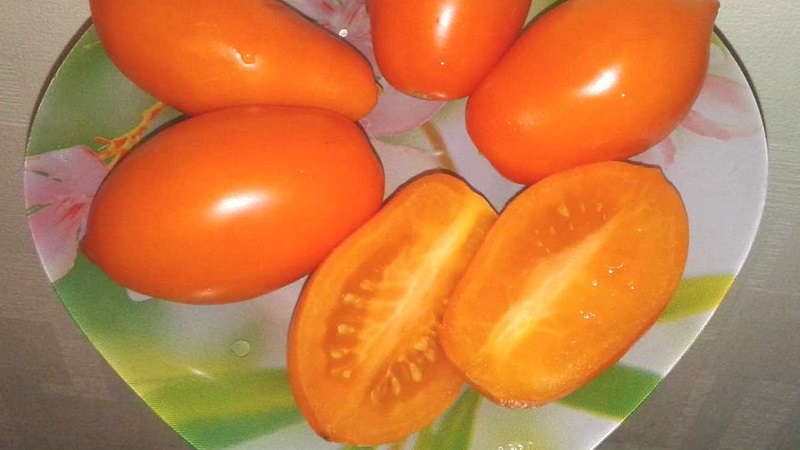
Unlike other varieties, this tomato has several advantages: grows easily and bears fruit in unfavorable conditions with increased rainfall and temperature changes. Even in such an environment, its yield does not decrease, as is the case with other types of tomatoes.
The variety Goldfish belongs to the mid-season... Fruits ripen in the interval of 105-120 days after the first seedlings hatch.
Vegetables have the following characteristics:
- small fruits weigh 90-110 g each;
- up to six of them ripen on one brush;
- color is bright yellow, closer to orange;
- the pulp of vegetables is dense and fleshy;
- the shape of the fruit is oblong, there is a peculiar spout at the tip;
- the taste of tomatoes is excellent, the pulp has a pleasant sweetness.
How to grow seedlings
To get a well-developed and healthy plant, you need to take good care of the seedlings.... You can buy it in nurseries or from trusted gardeners, but you cannot be completely sure of the planting material. Therefore, many are engaged in growing seedlings on their own.
Seed preparation
Store-bought fresh seeds require a minimum of preparation... The packaging often indicates that they are completely ready. The producers have already done everything necessary, and by the inept actions of the vegetable grower, their result can be reduced to zero. Such seeds are soaked in plain water before sowing, unless otherwise indicated on the package. With your own seeds from last year's harvest, you will have to tinker a little.
Step-by-step preparation includes the following activities:
- Seed selection. They are placed in a 3% sodium chloride solution. Those grains that float up after 5-7 minutes are not used, they can be safely thrown away. After the procedure, the good seeds are washed with water.
- Disinfection of seed is carried out for 20-30 minutes in a 1% solution of potassium permanganate, after which the seeds are washed with water.
- The seeds are kept in damp gauze until they hatch.
- When this happens, the cloth with all the grains is placed in the refrigerator for 2-3 days. Periodically they are taken out for 2-3 hours and put back.
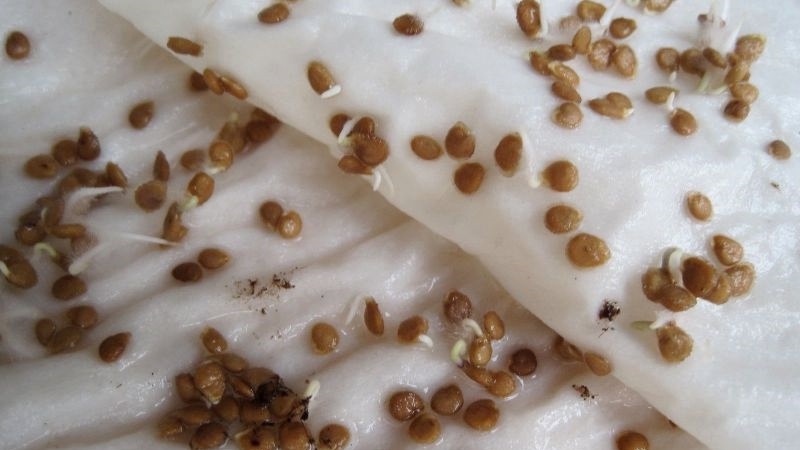
Capacity
Seedling utensils are important... The seeds can be sown in various containers:
- wooden boxes;
- seedling pots;
- trays-cassettes;
- peat tablets;
- disposable cups.
Moreover, each of the options has its pros and cons.... Trays-cassettes or boxes are more convenient and economical: they grow a large number of seedlings and simultaneously care for all the seedlings. If necessary, containers can always be moved to another place. They are compact and inexpensive. But shallow dishes are suitable for growing seedlings only until the moment of picking.
In deep trays or boxes in adult sprouts, the roots can get tangled, it will be difficult not to damage them when separating. If the seedlings are damaged, it will take a long time to take root or even die. The best option would be to choose trays or cassettes with partitions.
On a note. The most suitable trays or cassettes are 6-7 cm wide and 10-15 cm high. When buying a container, pay attention to what it is made of. Better to buy a tray (cassette) made of polystyrene. Do not purchase containers made of polyvinyl chloride, it contains poisonous substances.
Inexpensive, pots or disposable cups are best.... Seedlings can be grown in them until the plant is transplanted into open ground. The downside of containers is that they take up a lot of space. There must be drainage holes at the bottom of the pan.
The ideal option is peat tablets or cups... They promote root development and prevent seedling rot. The plant is placed in the soil along with the container, since peat dissolves in the ground over time. The disadvantage of peat tanks is their cost.
Read also:
Tomatoes "Honey fingers": grown wisely
Assortment of tomatoes "Königsberg": description of varieties
The soil
The soil for tomato seedlings can be purchased at a specialized store or prepared by yourself... It is better to buy peat soil.
For self-preparation of the soil, a little compost and humus are added to the loamy soil... In order for the seedlings to grow well, they are mixed with peat or sawdust to make the soil loose.
On a note. Coconut substrate is also used. It contains many nutrients that prevent plant rotting and promote root development.
Sowing
Seeds are sealed to a depth of 1.5 cm, the ground is not watered after planting... Then the container with seeds is covered with polyethylene. When sprouts begin to appear, the seedlings are transferred to a bright place. The room temperature should be within 24 ° C.
Growing and care
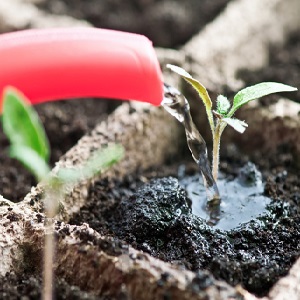 If the air humidity is low, the seedlings are watered more often when the plant is kept next to heating devices.... Lack of lighting or short daylight hours are compensated by special lamps.
If the air humidity is low, the seedlings are watered more often when the plant is kept next to heating devices.... Lack of lighting or short daylight hours are compensated by special lamps.
When growing seedlings, you need to remember important nuances.:
- As tomatoes grow, they stretch towards the light. For correct formation, the pot is turned to the light source in different directions.
- Young shoots are very tender and can get burned from direct sunlight.
- The soil taken from the garden can be infected with spores of fungi or eggs of parasites, therefore, before use, it is calcined or watered with a solution of potassium permanganate.
When 3-4 true leaves appear on the shoot, the seedlings dive into separate pots or cups and grow it there before transplanting to a permanent place.
How to grow tomatoes
Growing a yellow-fruited tomato variety consists of several stages., on each of which it is important to observe the cultivation technology. The variety is grown both in the greenhouse and in the open field.
Landing
There are no special agrotechnical methods here, you need to follow simple general rules:
- The variety is planted in the same way as all tall tomatoes: 40 cm is left between the plants, and 60-70 cm between the rows.
- Seedlings are planted in the greenhouse at the end of April, and in open ground, depending on the region.
- The holes are made about 20-25 cm deep, at the bottom of each place a small amount of soil with a teaspoon of complex fertilizer or superphosphate in combination with potassium nitrate.
- Fresh manure is not brought under the tomatoes in spring for two reasons: young plants can "burn" from the high content of urea, and if the crop does not die from fertilization, it will begin to fatten, that is, more green mass will grow to the detriment of fruit setting. Therefore, manure for tomatoes is applied in the fall, and in the spring they are fertilized with decomposed compost or humus.
- The seedlings should be 60-70 days old at the time of planting.
- In order to prevent the plant after planting, it is treated with copper oxychloride (30 g per 10 l of water).
- Overgrown seedlings are planted “lying down”, deepening the stem to the first leaves.
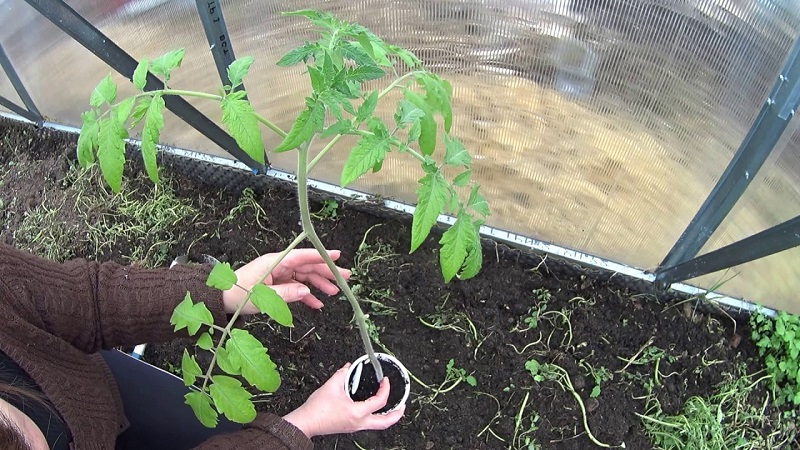
Care
Tomatoes are fed at least three times:
- After planting, two weeks later, the plant is fertilized with a solution of mullein or bird droppings (700 g per 10 liters of water), and ready-made preparations "Vermisil", "Humisol" are also used.
- The second time, fertilizer is applied at a time when flowers appear on the second cluster. The culture is fed with a superphosphate solution (a glass of the drug in a bucket of water).
- When the first fruits begin to ripen, a third feeding is carried out. The mullein solution is again used with the addition of complex fertilizer (50-100 g per bucket). At least 2 liters of solution are poured under each bush.
Foliar dressing also gives good results.... The bushes are sprayed with a superphosphate solution at the rate of 1 tbsp. l per 1 l of water.
Watering tomatoes too often is not required... The Goldfish variety comes from arid hot regions and does not experience a lack of moisture in ordinary years. In a drought, especially if the crop grows in a greenhouse, where rain does not fall, water at least once every 7-10 days.
After watering, when the water is well absorbed, loosening is carried out and damp soil is thrown to the stem... This promotes the formation of additional roots and makes the plant more resistant to negative factors, increases productivity. Weeds are removed along with loosening.
The fruit tie is made to a simple metal mesh with a polymer coating or pure polymer mesh with cells of at least 50 × 50 mm... The mesh is located between the supports and is attached to them, and tomatoes are already tied to it.
The variety Goldfish is an indeterminate plant (that is, it grows constantly)... The bush is formed into one stem. All processes on the tomato are removed, even those located at the bottom of the plant, leaving only the peduncles. In addition, bifurcated shoots are cut off, and if the top has split into two parts, then the strongest side is left.
Important! Pinching is carried out once a week. This allows the bush to ventilate and receive the maximum amount of light.
Features of cultivation and possible difficulties
Variety Goldfish for seedlings sown in early March... Tall tomatoes show great growth already in the seedling period. They will shade other plants on the windowsill and take up a lot of space.
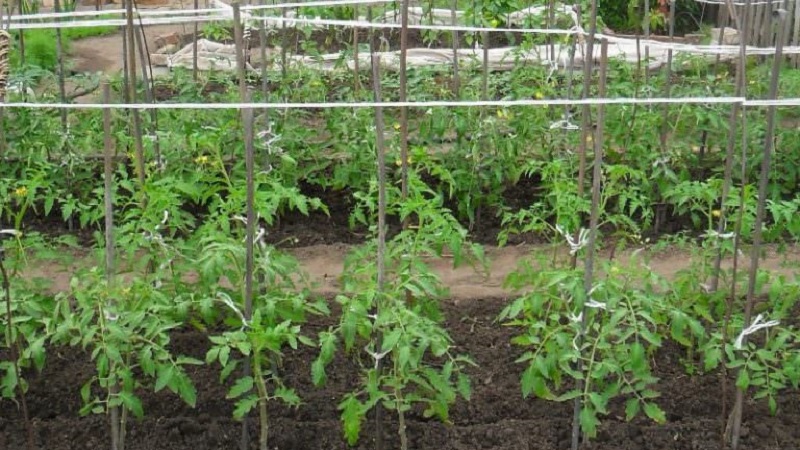
In addition to the traditional transplant, which is carried out when the first true leaves appear, another 2-3as the plants will quickly fill the cups or pots with roots.
Already at the sowing stage, the risk of infection with fungal diseases must be taken into account... The seeds are washed in a 1% solution of potassium permanganate, and the ground is disinfected, well spilled with boiling water, or heated in the oven to 100 ° C. Soil cultivation is carried out a week before sowing.
About other varieties of yellow tomatoes:
Sustainable tomatoes with high yields - the Golden Domes tomato
Diseases and pests
The most common diseases and pests affecting the variety:
- top rot;
- aphid;
- Colorado beetle.
Colorado potato beetle harms the plant the most.... For this reason, the culture is treated with special preparations, periodic inspection and collection of pests is carried out. Aphids are fought with tobacco dust or wood ash. If the plant lacks calcium or potassium, it can develop apical rot. To protect the culture from disease, 1% potassium or calcium solution is used.
For the prevention of late blight, seedlings are treated with a 1% solution of potassium permanganate (pour it over the soil composition). It is recommended to carry out this procedure every 10 days, it does not harm the tomatoes.
The nuances of growing
In tall tomatoes, the root system develops vertically, so there is no need to water the plant often... The roots go deep, receiving nourishment and moisture from the lower layers of the earth. For a bountiful harvest, vegetable growers carry out foliar feeding with boric acid.
Harvesting and application of the crop
Tomatoes are harvested on time, avoiding overripening... The fruits of the Goldfish are so beautiful that it is a pleasure to collect them.
On a note. Plucked tomatoes have a longer shelf life.
Tomatoes work well as an ingredient in vegetable salads... They look spectacularly marinated in glass jars, they are stored for a long time and can become a decoration of the New Year's table. Tomatoes are delicious, but they don't make juice and ketchup because the color will be unattractive.
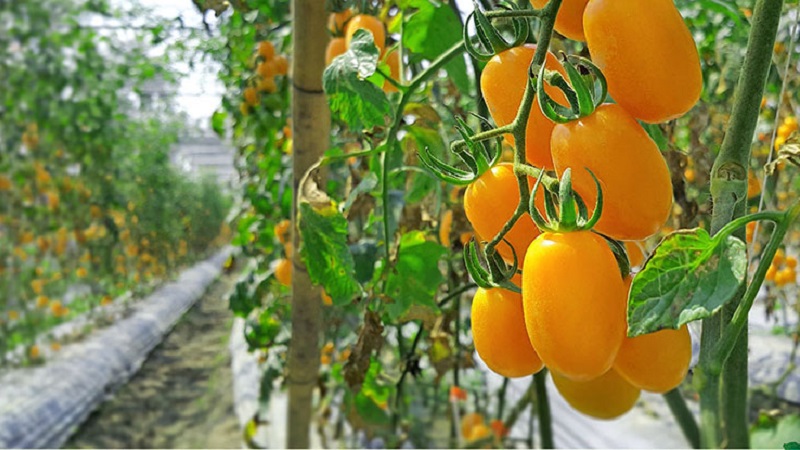
Advantages and disadvantages of the variety
There are no ideal varieties, each has its own advantages and disadvantages. The Goldfish has quite a lot of positive sides, but there are practically no downsides.
Benefits:
- transportability;
- the ability to preserve the whole fruit;
- good productivity;
- high taste;
- tomatoes do not crack;
- drought resistance;
- stored for a long time;
- yellow color indicates a high content of carotene;
- the ability to ripen on a removed brush;
- high content of tetra-cis-lycopene - an antioxidant enzyme.
Disadvantages of the variety:
- the need for pinning and garter to the support;
- weak immunity;
- long growth without ovaries.
Goldfish is rich in fiber, vitamins A, C and lycopene, does not contain cholesterol... However, in comparison with red varieties, this indicator is significantly lower.
Farmers reviews
The opinions of summer residents about the variety are mostly positive., however, there are still some nuances.
Evgeniya, Samara: “This variety was recommended to me by a neighbor in the country. I took the seedlings from her, since I still don't know how to grow. I planted the seedlings in the open ground, I didn't really bother with them. The only thing - it was fertilized with serum and treated with phytosporin. I liked the taste of the tomatoes, although they were slightly affected by the top rot. The harvest pleased me with its abundance, I decided to continue growing this variety! ".
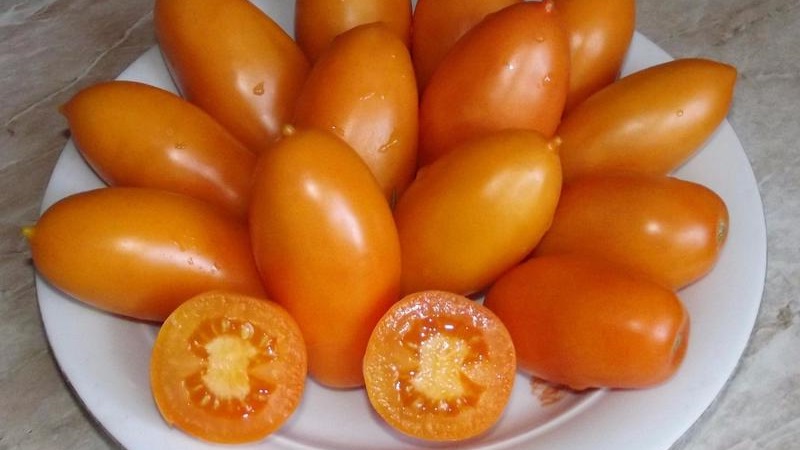
Dmitry, Bryansk: “I tried to plant a Goldfish in my polycarbonate greenhouse. The bushes came out high, in two trunks. The yield suited me perfectly, and the vegetables themselves turned out to be tasty and juicy with a sweetish aftertaste. The fruits are beautiful, as in the photo of the package. They lay in my cellar until early November, until they ate. I did not like the fact that there were several attempts at top rot to hit the bushes. I saved the situation by feeding ".
Christina, Borisoglebsk: “We have been growing Goldfish in a summer cottage greenhouse for five years now. Usually the bushes grow under the very roof, so you have to pinch, although it's a pity. All the time I form in two stems, but next year I want to try in three. The trunk of the bush is not very powerful, but curly, you have to tie it up. And the leaves look very similar to the tail of a goldfish! There are always more than enough tomatoes, they are very tasty by themselves. ".
Conclusion
Amateur gardeners often try to plant something new and original on their site. Tomato Goldfish combines exquisite appearance and unusually sweet taste. It is considered to be one of the best among yellow tomatoes. If you haven't grown this golden variety, take a look at it. Tomatoes have a minimal number of flaws, which are more than compensated for by their sweet taste and benefits.
You will learn detailed information about growing the variety in the following video: